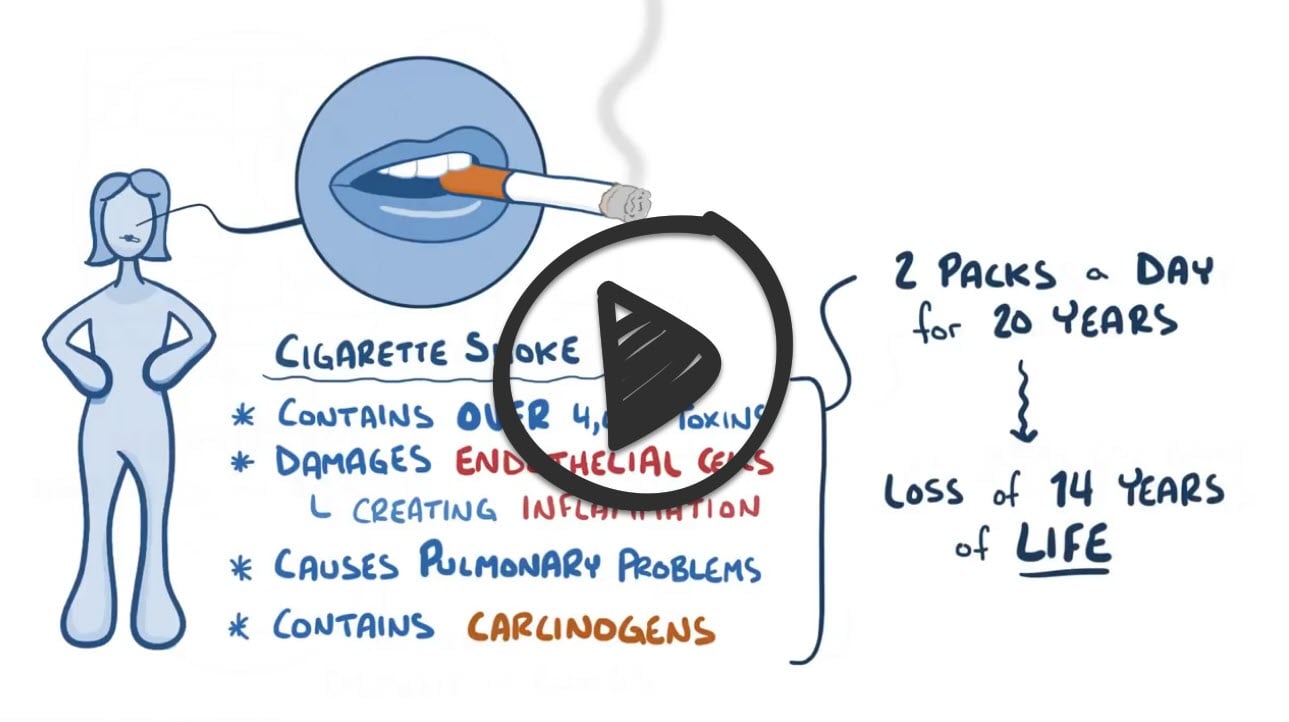One in five American adults, or about 45.3 million people living in the U.S., smoke cigarettes.
- After 50 years of steady decline in smoking prevalence, progress has stalled.
Approximately 30 percent of all patients undergoing elective general surgery procedures smoke, which means that an estimated 10 million operations are performed on smokers annually.
- Smoking within one year of surgery has been associated with increased postoperative complications, increased hospital costs, and higher resource use.
- Deleterious effects on wound healing also occur and are thought to be related to the nicotine content of conventional tobacco products as well as tobacco substitutes containing nicotine.
Optimally, patients who smoke should stop smoking at least 8 weeks before scheduled surgery.
- The highest rate of pulmonary complications in 200 patients undergoing CABG was in those who had stopped smoking 1-8 weeks preoperatively.
- Recent cessation of cigarette smoking may pose a greater risk of pulmonary complication because of the commonly observed increase in cough and sputum production.
- Patients should abstain from smoking for as long as possible both before and after surgery.
- Using nicotine gum around the time of surgery is not encouraged.
Smoking cessation before surgery is associated with demonstrable benefits.
- Short-term cessation results in a measurable reduction in vasoconstriction and irregular heart activity due to an immediate decrease in nicotine.
- The lack of oxygen to surgical wound sites and increased risk of blood clots are also reversed with short-term smoking cessation.
- Smoking-related impairment in wound healing and pulmonary function improve within four to eight weeks of smoking cessation.
- There is no evidence that short-term cessation is harmful perioperatively.
Helping patients quit:
The best methods for using pharmacotherapy for the surgical patient remain to be determined. If patients are willing to make a quit attempt at least weeks before surgery, bupropion can be used because drug therapy needs to begin 1 to 2 weeks before the quit date.
Perioperative nicotine replacement is controversial
- Any of several delivery methods for nicotine replacement NRT would be appropriate.
- If patients are willing to abstain only temporarily or set a quit date coincident with the surgical date, products such as nicotine gum or lozenges may be useful even on the morning of surgery to assist in maintaining the preoperative fast from cigarettes.
- Data suggest that use of NRT in hospitals is not routinely necessary to treat withdrawal symptoms, but this may be an excellent setting in which to initiate NRT under the guidance of health care providers.
Adults aged 50 to 80 years who have a 20 pack-year smoking history and currently smoke or have quit within the past 15 years:
- Screen for lung cancer with low-dose computed tomography (CT) every year
- Stop screening once a person has not smoked for 15 years or has a health problem that limits life expectancy or the ability to have lung surgery
Nicotine replacement therapy (NRT)
| Long-Acting | Short-acting | |
| Patch | Gum (Nicorette) | Lozenges |
Starting on quit day:
|
|
|
Chantix and Bupropion
| Chantix (Varenicline) | Bupropion (Zyban SR, Wellbutrin SR) |
Partial agonist at α4β2 subunit of the nicotinic acetylcholine receptor
Administration:
|
Enhances central nervous system noradrenergic and dopaminergic release
Administration:
|
Question 1 |
1 day | |
1 week | |
2 months | |
6 months | |
1 year |
Question 2 |
Pneumonia | |
Myocardial ischemia | |
Nausea and vomiting | |
Wound infection | |
Nonunion of fractured bones |
Question 3 |
They cannot smoke in the surgical facility Hint: Patients should not smoke in the surgical facility | |
They should try not to use NRT | |
Most people are free from cigarette cravings immediately after surgery Hint: Despite what people think most patients do not have cigarette cravings immediately after surgery | |
Around the time of surgery is a good time to quit
smoking permanently Hint: This is very true | |
Quitting smoking will help prevent complications
after surgery Hint: Quitting smoking will definitely help prevent complications
after surgery |
|
List |


 Osmosis
Osmosis